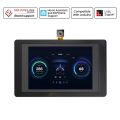Loud ESP Mini

What is it?
Loud ESP is an ESP32-powered, rich-audio development board. Available with or without a color touchscreen, Loud ESP has a wealth of peripherals to support a wide range of user interaction. It is compact, portable, battery-powered, and designed to accommodate a variety of enclosures, all of which make it an ideal platform for the development of wearables and other smart devices. To help out with that, we maintain a repository of sample code that you can adapt for your own applications. Wireless, Touchscreen-Enabled Versatility for Audio Applications
Loud ESP is well suited for a number of different applications. To name just a few examples, it can be used as a portable speaker system with Wi-Fi and Bluetooth compatible capability, an internet-radio receiver, a framework for developing wearables and talking gadgets, or a smart speaker connected to the platform of your choice, such as Spotify.
Features & Specifications
MCU Core
ESP32 Dual Core 32-bit LX6 microprocessor running at 240 MHz
16 MB of flash storage
8 MB of PSRAM
CP2102 Serial communication / Flashing chip
Battery management
Li-Ion battery charging with charge status indication
Battery overcharge and overdischarge protection
Battery overcurrent protection
Battery voltage reading using built-in DAC
Onboard power switch
2-pin connector for external battery
onboard, 14500 battery holder (touchscreen version only)
Audio capabilities
Dual I2S stereo DAC (Maxim Integrated MAX98537) with built in D-Class amp
3 W per channel on 4 Ohm load
Up to 92% efficiency
Onboard 5.5 V boost converter
Peripherals
Wi-Fi & Bluetooth
RGB LED, RGB LED strip header
2.8", 320 x 240 px TFT Screen with touch sensor (touchscreen version only)
IR reader (touchscreen version only)
SD Card slot (touchscreen version only)
JTAG header (touchscreen version only)
Rotary encoder/Joystick header (touchscreen version only)
Other
RESET and GPIO0 (FLASH) buttons
Software samples for every onboard peripheral
Mechanical compatibility with Raspberry Pi 4 enclosures (touchscreen version only)
Support & Documentation
You can find documentation such as board schematics, firmware, and sample code in our GitHub repository. You can also follow our progress on Hackaday.io










































